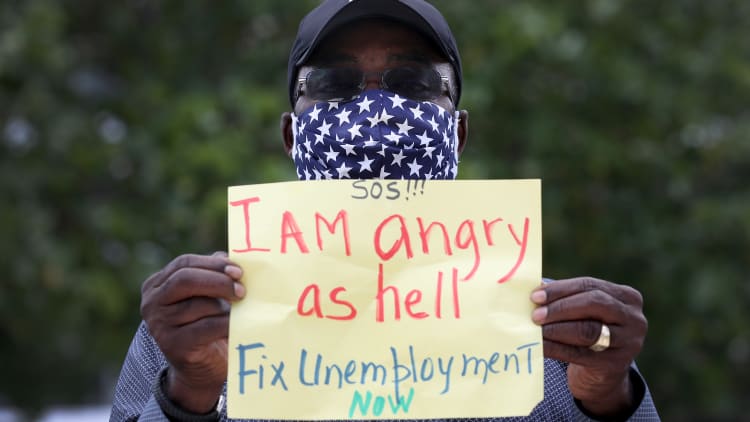On Saturday, Arizona, Iowa, Louisiana and New Mexico became the first states approved to pay out the new $300 federal unemployment boost created by President Donald Trump's memorandum on jobless benefits signed on August 8.
The order establishes a new "lost wages assistance" program that will draw from $44 billion in funding from the Federal Emergency Management Agency (FEMA). Through the program, the federal government will provide eligible recipients with an additional $300 payment on top of their state-administered unemployment aid. States may kick in another $100 if they have the funding to do so.
The $300 federal payments are intended to replace the former $600 boost provided by the CARES Act that expired July 31.
On Sunday, FEMA approved applications from Colorado, Missouri and Utah to administer the lost wages program.
Boosted benefits could roll out in August
Following the signing of the memorandum, Treasury Secretary Steven Mnuchin said jobless benefits could be available "immediately," The Washington Post reports; meanwhile, White House economic adviser Larry Kudlow said on CNN that payments could take a couple of weeks.
New guidance from FEMA estimates payments will take at least three weeks from August 8 to start rolling out.
States and territories must formally apply for the aid and outline how they plan to administer payments. After they're approved, funding will be available "within one business day of receipt of the fully executed grant award," the guidance says. FEMA notes that after the memorandum was signed August 8, they approved the first round of states to receive aid by August 14.
How long it will take for residents to actually receive extra payments will depend on how quickly states can reprogram their unemployment insurance systems to administer the funds. States that immediately got to work to reconfigure their systems on August 8 could start administering extra payments by August 29, according to the Department of Labor.
And Arizona residents could see the boost as soon as this week.
Deputy Press Secretary Brett Bezio of the Arizona Department of Economic Security wrote in a statement to Forbes this week: "Arizona has received approval on its application to FEMA for Lost Wages Assistance (LWA) funding. The Department has implemented these changes to its system, and funds will be issued to claimants starting this week."
Many workers will receive an extra $300 per week
The new order says that, through a combination of federal and state dollars, unemployment recipients can receive up to an extra $400 per week in aid.
However, through the program, the federal government will provide $300 per week per person, while states would be responsible for the remaining $100.
States strapped for funding may consider their regular unemployment insurance payments as their $100 "match," rather than adding aid on top, effectively leaving benefits recipients with a $300 weekly boost overall.

The lowest-paid workers won't be eligible for new aid
Once their state is set up, the FEMA guidance says people already receiving jobless benefits will see the supplemental aid come through with their regular state payments, retroactive to August 1.
The extra payment will go to people receiving benefits from regular state unemployment, Pandemic Unemployment Assistance, Pandemic Emergency Unemployment Compensation and state-administered extended benefits.
However, individuals must be collecting a minimum benefit of at least $100 a week in order to qualify for the boost, a provision the Trump administration said is to curb fraud. The $100 minimum requirement could exclude an estimated 1 million of the lowest-paid workers.
Not all states will pay the extra aid
Not all states are planning to take part in the program. South Dakota Gov. Kristi Noem announced Friday that the state would not take up the Trump order to provide the $300 weekly boost to jobless residents.
"My administration is very grateful for the additional flexibility that this effort would have provided, but South Dakota is in the fortunate position of not needing to accept it," Noem said in a statement.
Nearly 19,000 people are collecting unemployment benefits in South Dakota, and its insured unemployment rate — the number of workers getting jobless benefits as a percentage of its labor force — is 3.7%, the second-lowest in the nation behind Idaho. (The U.S. average is around 11%.)
States must submit their grant applications and administrative plans by September 10 in order to be considered for funding.
Federal funding may not last long
States approved for the lost wages program are only guaranteed three weeks of funding, according to FEMA guidance, and additional disbursements will be made on a weekly basis "in order to ensure that funding remains available for the states who apply for the grant assistance."
According to the president's order, the federal lost wages program will run until December 6; until the $44 billion FEMA aid runs out; until the national Disaster Relief Fund, which normally funds emergency weather-related aid but will now also fund boosted unemployment, depletes to $25 billion; or until Congress passes new legislation regarding federal unemployment benefits — whichever occurs first.
Analysts with the Committee for a Responsible Federal Budget estimate the $44 billion in FEMA resources would last roughly five weeks, until August 29, 2020. That means, by the time some Americans begin to see federal aid, funds could already be running out yet again.
States administering the $100 weekly boost may continue to do so until December 27. All remaining forms of enhanced unemployment are set to expire at the end of 2020.
Members of Congress and White House officials spent several weeks negotiating the next round of pandemic relief, which came to an abrupt halt last week as the Senate adjourned for recess until Labor Day.
Some 28 million Americans are currently receiving jobless benefits.
CNBC Make It is NOW STREAMING on Peacock. Find our original programming in the Channels section.
Don't miss:
Parents may qualify for paid leave, unemployment if schools are closed for the fall
Nearly half of all furloughed workers now believe their temporary layoff will become permanent



